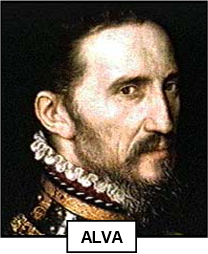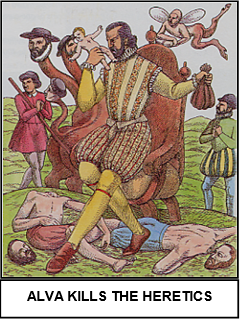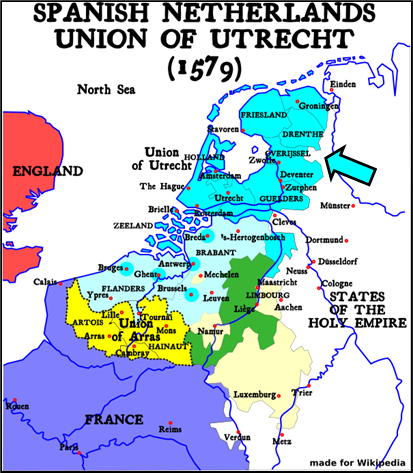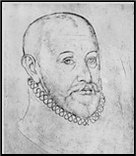


xxxxxPhilip, son of Charles V, inherited the Netherlands from his father in 1555. Determined to stamp out the growth of Protestantism there, he began the systematic killing of thousands of "heretics". When this eventually led to an open rebellion, he appointed the Duke of Alva as Governor in 1567. He introduced a reign of terror via his "Council of Blood", but the mass killings only served to widen the insurrection. Even Catholics joined the revolt in protest against heavy taxation, and by 1573 Philip was faced with a war of independence. Alva was summoned back to Spain, and the Council of Blood was abolished, but the persecution continued. As we shall see, in 1581 the seven provinces in the north, all members of the Union of Utrecht, made their first attempt to throw off Spanish rule.
THE DUKE OF ALVA -
Acknowledgements
Alva: detail from
portrait by the Netherlandish painter Antonis Mor (1519-
 xxxxxAs we have seen, Emperor Charles V, who had inherited
the Netherlands from his father in 1506, handed over this
territory to his son, Philip II, in 1555. In general, the
Emperor's rule had been a benevolent one -
xxxxxAs we have seen, Emperor Charles V, who had inherited
the Netherlands from his father in 1506, handed over this
territory to his son, Philip II, in 1555. In general, the
Emperor's rule had been a benevolent one - of
"heretics". Protests by leading nobles, such as William I of
Orange and the general and statesman the Count of Egmont, went
unheeded. In 1566 open rebellion broke out, and many Catholic
churches were attacked.
of
"heretics". Protests by leading nobles, such as William I of
Orange and the general and statesman the Count of Egmont, went
unheeded. In 1566 open rebellion broke out, and many Catholic
churches were attacked.
xxxxxTo meet
this new threat, in 1567 Philip sent an
army of 10,000 men to the Netherlands under the command of the
Duke of Alva, a competent soldier who had served Charles V well in
Tunisia, and Philip with distinction in Italy. Maintaining his
reputation for cruelty, he instituted a reign of terror by means
of his Council of Troubles, which came to be known as the "Council
of Blood". This body condemned and executed thousands of people -
 xxxxxSuch was the growing intensity of the opposition to
his draconian rule that by 1572 there was widespread insurrection
throughout the country. And by now many Catholics were adding
their support as a protest against a 10% sales tax Alva had
introduced, known popularly as the "Tenth Penny". Thus in the
space of a few years his policies had turned a rebellion into a
war of independence. By 1573 Philip II had realised his mistake.
Alva was summoned back to Spain, to be employed more successfully
a few years later during the Spanish conquest of Portugal.
xxxxxSuch was the growing intensity of the opposition to
his draconian rule that by 1572 there was widespread insurrection
throughout the country. And by now many Catholics were adding
their support as a protest against a 10% sales tax Alva had
introduced, known popularly as the "Tenth Penny". Thus in the
space of a few years his policies had turned a rebellion into a
war of independence. By 1573 Philip II had realised his mistake.
Alva was summoned back to Spain, to be employed more successfully
a few years later during the Spanish conquest of Portugal.
xxxxxFollowing his departure, the "Council of Blood" was abolished, but the killing continued. In 1576, for example, the Spanish wreaked their fury on Antwerp, burning, looting and slaughtering some 8,000 of the city's inhabitants. In response, leaders of the Catholic south and the Protestant north attempted to unite by signing the Pacification of Ghent, but their differences proved too great, not only on religious grounds, and the understanding collapsed three years later. As we shall see, in 1581 seven provinces in the north (arrowed on map), all members of the Union of Utrecht of 1579, declared their independence from Spain, but it was to be many years before there was to be any hope of a lasting settlement for the Protestant north, let alone the Catholic south.
 xxxxxIncidentally, the execution
of the Flemish general and statesman the Count of Egmont
(1522-
xxxxxIncidentally, the execution
of the Flemish general and statesman the Count of Egmont
(1522-
L1-


